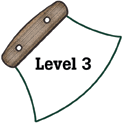
Alaska Science
Key Element A14a
A student who meets the content standard should understand the interdependence between living things and their environments (Interdependence).
 |
Alaska Science A student who meets the content standard should understand the interdependence between living things and their environments (Interdependence). |
|
Performance Standard Level 3, Ages 11–14
|
|
|
|
Sample Assessment Ideas
|
|
|
Expanded Sample Assessment Idea
|
|
Procedure Students will:
Reflection and Revision
|
Levels of Performance |
||
|
Stage 4 |
Student work is complete, and shows evidence of clear and logical reasoning. Student conducts a thorough investigation of an animal and produces a detailed food web that includes organisms from all trophic levels of the food chain. Student correctly identifies predators in direct competition with one another and explains how these animals avoid direct competition. Student work shows extensive evidence of transfer and extension of knowledge in a detailed discussion of how an organism’s change affects the food web. | ||
|
Stage 3
|
Student work shows evidence of logical reasoning, but may contain minor errors or omissions. Student conducts an investigation of an animal and produces a food web that includes organisms from all trophic levels of the food chain. Student correctly identifies predators in direct competition with one another and explains how two of these animals avoid direct competition. Student work shows evidence of transfer and extension of knowledge in a discussion of how an organism’s change affects the food web. | ||
|
Stage 2
|
Student work may be incomplete, or contain errors of science fact and reasoning. Student conducts an investigation of an animal and produces a simple food chain. Student may identify another animal that competes for food or other resources. Student work shows limited evidence of transfer and extension of knowledge. | ||
|
Stage 1
|
Student work is largely incomplete, and may contain major misconceptions regarding an animal and its needs or complex food chain. | ||
Standards Cross-References
|
||
|
National Science Education Standards Living systems at all levels of organization demonstrate the complementary nature of structure and function. Important levels of organization for structure and function include cells, organs, tissues, organ systems, whole organisms, and ecosystems. (Page 156) Populations of organisms can be categorized by the function they serve in an ecosystem. Plants and some microorganisms are producers—they make their own food. All animals, including humans, are consumers, which obtain food by eating other organisms. Decomposers, primarily bacteria and fungi, are consumers that use waste materials and dead organisms for food. Food webs identify the relationships among producers, consumers, and decomposers in an ecosystem. (Page 157) The number of organisms an ecosystem can support depends on the resources available and abiotic factors, such as quantity of light and water, range of temperatures, and soil composition. Given adequate biotic and abiotic resources and no disease or predators, populations (including humans) increase at rapid rates. Lack of resources and other factors, such as predation and climate, limit the growth of populations in specific niches in the ecosystem. (Page 158) |
Benchmarks In all environments-freshwater, marine, forest, desert, grassland, mountain and others-organisms with similar needs may compete with one another for resources, including food, space, water, air, and shelter. In any particular environment, the growth and survival of organisms depend on the physical condition. (Page 117) Two types of organisms may interact with one another in several ways: They may be in a producer/consumer, predator/prey, or parasite/host relationship. Or one organism may scavenge or decompose another. Relationships may be competitive or mutually beneficial. Some species have become so adapted to each other that neither could survive without the other. (Page 117) |
|
Table of Contents | Return to Alaska Native Knowledge Network